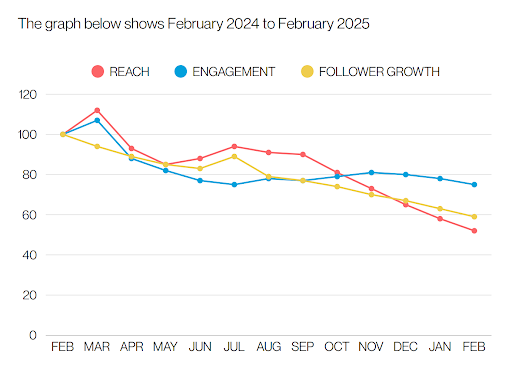Late last year LinkedIn changed its algorithm, signaling a pivot in its business strategy and taking a dramatic shift. The question is, why?
Has LinkedIn come to the realization that other social platforms are increasingly coming after business (especially small business) or is it their advertising model they covet?
The truth is, LinkedIn needs growth. Revenue growth has slowed to 9% in 2023 and 2024, driven mostly by premium subscription and talent solutions.
And new growth looks like advertising, and lots of it. The old free “networking” platform is quickly transitioning to becoming an ad platform.
The Change
Many users of the platform will tell you they saw a dramatic decrease in their engagement metrics at the end of last year. According to Richard van der Blom and Just Connecting’s Algorithm Insights Report 2025, overall organic reach has declined 50% over the last year in hope of connecting content with the right audience…quality over quantity.

LinkedIn’s AI-driven ranking systems now resemble those of platforms like Instagram and TikTok, meaning you are more likely to see content coming from less creators, and more from creators you engage and/or connect with. Compared to the past which was more balanced towards professional relevance and interest.
Just as the other platforms mentioned have created content “rabbit holes” to dive into, those same content holes are being created in a quest to drive deeper engagement. Where it was once believed that LinkedIn favored organic content creators, it’s now fully on the side of the content consumers. For businesses, this change (unless you have a broad following) means that little of the content that you are sharing on your corporate page will make it through to your audiences organically. In fact, according to a report, organic corporate page content showing in a LI feed has now fallen to 2% in 2024.
The Big Push for Video
What is increasing is video. Lots of it. The use of video increased by 69% in the past year according to the Algorithm report and Daniel Shapero, LinkedIn’s COO who stated that viewer time has increased by 36% year-over-year.
To continue the push to video, LinkedIn has now built a staple of 50+ B2B influencers to promote it. They’ve signed business partnerships with well-known content creators, like Steven Bartlett (The Diary of a CEO), Guy Raz (How I Built This), and Allie K. Miller (AI Business), to make more video content for the platform. Anyone want to guess why?
If you guessed ‘to sell more advertising’, you’re correct. Mr. Shapero also stated that advertising revenues saw significant growth in the quarter, and they see video as a great way to extend business reach.
What Does it Mean for Business and Paid Social?
The first question…is LinkedIn an important media channel for your business? If so, then the second question is, what is the goal? What is your expectation – do you see it as an awareness or demand generation channel?
If it is the latter, you may find the new direction frustrating. LinkedIn pushes video mostly for reach and impressions. And, as I mentioned in my last post, LinkedIn posts and promotions are very difficult to connect to business impact metrics. You may be better off investing in LinkedIn’s Sales Navigator.
If the goal is awareness, then you are in luck! Here’s what you need to do in order to align with the new direction.
- Ramp up video – Identify thought leaders who are camera ready to use for short form videos. Candidates should be subject matter leaders and not salespeople.
- Videos should be vertical in format and under 1 min in run time.
- Shift budget from promoting posts on your LinkedIn corporate page to higher performing thought leadership ads sponsoring videos.
- Posting video should be done by the person featured and reshared by the corporate page…and hopefully, employees within your organization.
- Focus on storytelling. Personal stories perform best. Go easy on the selling.
- Link your metrics to track performance from impressions to form fill or website visit.
Will it Work?
LinkedIn says that the changes have been made in an effort to bring more of the content consumers want by mining engagement data. By doing this, it is restricting the organic reach of content creators. And that organic reach drove results, according to The Social Shepherd, 77% of B2B marketers said that organic content and engagement produced the best results.
Now those creators will be ones who will be buying the ads. The question is, can they create the quality and style of content that will fit the new advertising vehicles, like Thought Leadership ads.
Will LinkedIn influencers be effective? If you don’t have the inhouse talent to build a following you may consider “renting” one. But, a business audience is very different from a consumer audience. Will LinkedIn influencers be creditable enough to move an audience to take action?
All good questions that we’ll watch play out over time. In the short-term ad revenue will grow, but in the long run, will it adversely impact user experience? One thing is certain, you will see more sponsored content, especially from LinkedIn, on your feed.
I don’t knock LinkedIn for making the pivot. TikTok owns small business retail and Instagram is coming for corporations. Business buyers are consumers and have been programmed to prefer video on social feeds.
Users of “free” platforms also get that is a price to pay for usage, but will this pivot drive users to spend less time on it. Currently, 16% of users check in daily for an average of 1 minute and 17 seconds, according to The Social Shepherd.
Let’s also keep in mind that the platform was built and grew by catering to recruiters and job seekers. Can it balance the need for revenue growth while staying true to its original charter?
It’s a big bet and only time will tell. TikTok goes the clock…







